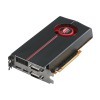- Qualcomm Launches Snapdragon 4 Gen 2 Mobile Platform
- AMD Launches Ryzen PRO 7000 Series Mobile & Desktop Platform
- Intel Launches Sleek Single-Slot Arc Pro A60 Workstation Graphics Card
- NVIDIA Announces Latest Ada Lovelace Additions: GeForce RTX 4060 Ti & RTX 4060
- Maxon Redshift With AMD Radeon GPU Rendering Support Now Available
ATI Radeon HD 5770 – DirectX 11 for the Masses

AMD may have released its first Evergreen GPUs mere weeks ago, but don’t think it’s slowing down for anybody. The company has followed-up with its first mid-range parts, belonging to the HD 5700 series. Performance is much more modest on these new cards, but no features have been scrapped. It’s all here… DirectX 11, Eyefinity and more.
Page 12 – Overclocking ATI’s Radeon HD 5770
Before tackling our overclocking results, let’s first clear up what we consider to be a real overclock and how we go about achieving it. If you read our processor reviews, you might already be aware that we don’t care too much for an unstable overclock. It might look good on paper, but if it’s not stable, then it won’t be used. Very few people purchase a new GPU for the sole purpose of finding the maximum overclock, which is why we focus on finding what’s stable and usable.
To find the max stable overclock on an ATI card, we stick to using ATI’s Catalyst Overdrive tool. Compared to what’s available on the NVIDIA side, it’s quite limited in the top-end, but it’s the most robust and simplest solution to use. For NVIDIA, we use EVGA’s Precision, which allows us to reach heights that are in no way sane – a good thing.
Once we find what we believe might be a stable overclock, the card is put through 30 minutes of torture with the help of OCCT 3.0’s GPU stress-test, which we find to push any graphics card harder than any other stress-tester we’ve ever used. If the card passes there, we then further verify by running the card through a 2x run of 3DMark Vantage’s Extreme setting. Finally, games are quickly loaded and tested out to assure we haven’t introduced any side-effects.
If all these tests pass without issue, we consider the overclock to be stable.
Overclocking ATI’s Radeon HD 5770
Most ATI cards I’ve dealt with over the past year have overclocked quite well, but I didn’t have too much luck with the HD 5770. Although I reached some amazing clocks that I thought were stable (1+ hour OCCT stable), actually playing a game would show me otherwise. It’s actually rather frustrating to see an awesome overclock fly through OCCT’s brutal GPU test, only to have a game lock up within 5 – 10 minutes of gameplay. On the other hand, it really does prove that you can’t only trust one source for stability.
After much tinkering, the max stable clocks I hit was 910MHz to the Core (+60MHz) and 1225MHz for the Memory (+25MHz). Again, not too impressive of an overclock, but how does the extra oomph translate into real performance?


The answer is… not too well. The gains in most of the games are so minor, that unless you manage to reach a higher stable clock than what I hit, it can be argued that it’s not worth overclocking at all. What’s the point of putting additional stress on the card, and increasing the power consumption, for a mere 1 – 3 FPS?
Support our efforts! With ad revenue at an all-time low for written websites, we're relying more than ever on reader support to help us continue putting so much effort into this type of content. You can support us by becoming a Patron, or by using our Amazon shopping affiliate links listed through our articles. Thanks for your support!





